Palpable radial pulses - Study guides, Class notes & Summaries
Looking for the best study guides, study notes and summaries about Palpable radial pulses? On this page you'll find 1122 study documents about Palpable radial pulses.
Page 2 out of 1.122 results
Sort by
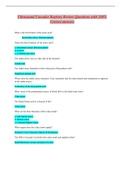
-
ARDMS (RVT) Ultrasound Vascular Registry Review Questions with 100% Correct answers
- Exam (elaborations) • 27 pages • 2023
- Available in package deal
-
- $13.99
- 7x sold
- + learn more
ARDMS (RVT) Ultrasound Vascular Registry Review Questions with 100% Correct answers Ultrasound Vascular Registry Review Questions with 100% Correct answers What is the first branch of the aortic arch? Innominate artery/ Brachiocephalic Name the three branches of the aortic arch? a. Innominate artery/ Brachiocephalic b. Lt CCA c. Lt Subclavian artery The radial artery runs on what side of the forearm? Lateral side The radial artery branches to form what part of the palmar arch? Supe...
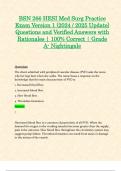
-
BSN 266 HESI Med Surg Practice Exam Version 1 (2024 / 2025 Update) Questions and Verified Answers with Rationales | 100% Correct | Grade A - Nightingale
- Exam (elaborations) • 90 pages • 2024
- Available in package deal
-
- $7.99
- + learn more
BSN 266 HESI Med Surg Practice Exam Version 1 (2024 / 2025 Update) Questions and Verified Answers with Rationales | 100% Correct | Grade A - Nightingale Q: The client admitted with peripheral vascular disease (PVD) asks the nurse why her legs hurt when she walks. The nurse bases a response on the knowledge that the main characteristic of PVD is: 1. Decreased blood flow. 2. Increased blood flow. 3. Slow blood flow. 4. Thrombus formation. Answer: 1 Decreased blood flow is a common characteristic o...
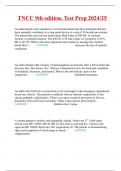
-
TNCC 9th edition. Test Prep 2024/25
- Exam (elaborations) • 11 pages • 2024
- Available in package deal
-
- $11.49
- + learn more
TNCC 9th edition. Test Prep 2024/25 An adult patient who sustained a severe head trauma has been intubated and has been manually ventilated via a bag mask device at a rate of 18 breaths per minute. The patient has received one intravenous fluid bolus of 500 ML of warmed isotonic crystalloid solution. The PaCO2 is 30 and a pulse ox symmetry is 92%. BP is 142/70. What is the most important intervention to manage the cerebral blood flow? - ANSWER decr...

-
TNCC 9th edition. Test Prep 2024/25
- Exam (elaborations) • 11 pages • 2024
- Available in package deal
-
- $11.49
- + learn more
TNCC 9th edition. Test Prep 2024/25 An adult patient who sustained a severe head trauma has been intubated and has been manually ventilated via a bag mask device at a rate of 18 breaths per minute. The patient has received one intravenous fluid bolus of 500 ML of warmed isotonic crystalloid solution. The PaCO2 is 30 and a pulse ox symmetry is 92%. BP is 142/70. What is the most important intervention to manage the cerebral blood flow? - ANSWER decr...
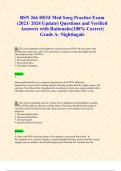
-
BSN 266 HESI Med Surg Practice Exam Version 1 (2023/ 2024 Update) Questions and Verified Answers with Rationales|100% Correct| Grade A- Nightingale
- Exam (elaborations) • 48 pages • 2023
-
Available in package deal
-
- $11.49
- + learn more
BSN 266 HESI Med Surg Practice Exam Version 1 (2023/ 2024 Update) Questions and Verified Answers with Rationales|100% Correct| Grade A- Nightingale Q: The client admitted with peripheral vascular disease (PVD) asks the nurse why her legs hurt when she walks. The nurse bases a response on the knowledge that the main characteristic of PVD is: 1. Decreased blood flow. 2. Increased blood flow. 3. Slow blood flow. 4. Thrombus formation. Answer: 1 Decreased blood flow is a common c...
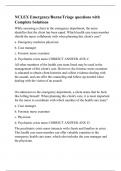
-
NCLEX Emergency/Burns/Triage questions with Complete Solutions
- Exam (elaborations) • 64 pages • 2024
-
- $17.99
- + learn more
While assessing a client in the emergency department, the nurse identifies that the client has been raped. Which health care team member should the nurse collaborate with when planning this client's care? a. Emergency medicine physician b. Case manager c. Forensic nurse examiner d. Psychiatric crisis nurse CORRECT ANSWER ANS: C All other members of the health care team listed may be used in the management of this client's care. However, the forensic nurse examiner is educated to obtain cl...
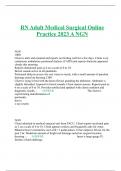
-
RN Adult Medical Surgical Online Practice 2023 A NGN
- Exam (elaborations) • 23 pages • 2024
-
- $12.49
- + learn more
RN Adult Medical Surgical Online Practice 2023 A NGN NGN 1000: Client is alert and oriented and reports not feeling well for a few days. Client is on continuous ambulatory peritoneal dialysis (CAPD) and reports dialysate appeared cloudy this morning. Reports abdominal pain as 4 on a scale of 0 to 10. Bowel sounds active in all quadrants. Peritoneal dialysis access site red, warm to touch, with a small amount of purulent drainage noted on dressing.1300: Client is lying in bed with th...

-
Novel Coronavirus Disease (COVID-19) Part III: Critical Care Unfolding Reasoning - John Taylor, 68 years old, Case Study.
- Case • 16 pages • 2023
-
- $14.49
- 1x sold
- + learn more
Novel Coronavirus Disease (COVID-19) Part III: Critical Care Unfolding Reasoning - John Taylor, 68 years old, Case Study. Novel Coronavirus Disease (COVID-19) Part III: Critical Care Unfolding Reasoning John Taylor, 68 years old Primary Concept Immunity/Gas Exchange/Perfusion Interrelated Concepts (In order of emphasis) Clinical judgment Communication Acid-base balance Patient education NCLEX Client Need Categories Covered in Case Study NCSBN Clinical Judgment Mod...
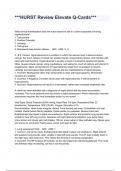
-
***HURST Review Elevate Q-Cards*** Exam Questions And Answers All Verified By An Expert
- Exam (elaborations) • 274 pages • 2024
-
- $13.49
- + learn more
***HURST Review Elevate Q-Cards*** Exam Questions And Answers All Verified By An Expert What clinical manifestation does the nurse expect to see in a client suspected of having hypercalcemia? 1. Tachycardia 2. Positive Chvostek 3. Lethargy 4. Tachypnea 5. Decreased deep tendon reflexes - ANS ANS: 3., 5. 3., & 5. Correct: Hypercalcemia is a condition in which the calcium level in blood is above normal. Too much calcium in blood can weaken bones, create kidney stones, and interfere...
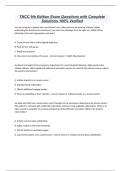
-
TNCC 9th Edition Exam Questions with Complete Solutions 100% Verified
- Exam (elaborations) • 11 pages • 2024
- Available in package deal
-
- $9.99
- + learn more
TNCC 9th Edition Exam Questions with Complete Solutions 100% Verified You are caring for a patient who was thrown from a bike and was not wearing a helmet. While performing the head-to-toe assessment, you note clear drainage from the right ear. Which of the following is the most appropriate next step? A. Clean the ear with a cotton-tipped applicator. B. Pack the ear with gauze. C. Notify the physician D. Document and continue the exam. - Correct Answer C. Notify the physician A patient...

How did he do that? By selling his study resources on Stuvia. Try it yourself! Discover all about earning on Stuvia


